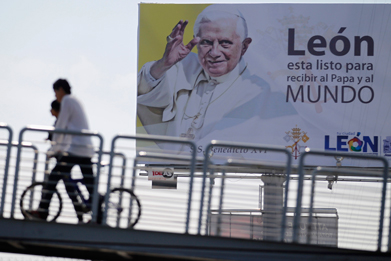by Patricia Zapor

HAVANA (CNS) – The 52 seminarians at San Carlos and San Ambrosio Seminary outside of Havana have a daunting task ahead of them, but a great deal of enthusiasm for how to tackle it.
They will join only about 300 priests in the whole country – one priest per every 19,000 Catholics – the widest ratio in Latin America and the Caribbean. But they will step into ministry at a time when the Catholic Church is regaining ground lost in the early days of the Cuban revolution, expanding services and becoming a more public presence in society.
Two high-profile Catholic events are part of what is inspiring the seminarians. Pope Benedict XVI will visit Cuba March 26-28, just the second visit of a pope to the country. And he’s coming as a pilgrim to mark the 400th anniversary of the country’s patroness, Our Lady of Charity of El Cobre – a celebration that already was a nationwide sensation before the pope’s visit was announced.
Kenny Fdez Delgado, a theology student and a native of Havana, told Catholic News Service in February that the seminarians are well aware of the huge jobs facing them as priests.
“There are shortages of priests everywhere, but there is really a shortage in Cuba,” Fdez said. “Some dioceses have just 30 priests in the whole diocese. It’s been an occasion for the laity to be more involved, but we still need priests for the sacraments.”
Elixander Torres Perez, another theology student, said part of the responsibility facing him and the other seminarians is “to be a means of unity” for Cubans and “to reconcile hearts.”
This is the role for priests “not only here in our country, but everywhere,” he added.
Fdez also looks beyond Cuba’s borders. “I think the greatest challenge is to be the means of peace between northern Cubans (meaning those living in the United States) and those here,” he said. “There is 50 years’ worth of hatred and resentment, and we need to be the means of peace.”
Within Cuba, there also needs to be healing, he added.
“There is dissent between some who are in favor of the government and others who want change,” Fdez noted. “It is hard to keep unity.”
The students said they have been energized by the pilgrimage tour of a statue of La Caridad, as the patroness is affectionately called.
“It opened the door for our hearts and for our faith,” said Torres. “It was an amazing event for me and for our country.”
Fdez was equally enthused: “I didn’t know so many Cubans had such a love for the Virgin. Spiritual need, that was what brought them out.”
As the replica statue toured the country in 2011, thousands of people turned out at each stop for processions, Masses and prayer services, far exceeding even the most optimistic expectations of the organizers.
Father Jose Miguel Gonzalez Martin, the Spanish rector of the seminary who also serves as pastor of Holy Spirit Parish in Havana, is one of more than 150 foreign priests who make up that total of 300. Hundreds of Cuba’s priests fled or were forced into exile after Fidel Castro rose to power in 1959. Then 30 years of official state atheism – dropped in 1992 – were an effective dampener on active involvement in religion.
Father Gonzalez said that in his 12 years in Cuba, he has seen the church become able to work more freely, “without fear,” in its evangelization efforts. After decades of overt oppression in an officially atheist state, there are more openings for the church’s social mission, in particular, he said.
The shortage of priests is one of the hardest challenges facing the church, he said. San Carlos and San Ambrosio operates at only about half its 100-seminarian capacity. Of the 11 dioceses in Cuba, one has no seminarians in Havana. The Archdiocese of Santiago de Cuba, in the far eastern part of the country, and the Archdiocese of Camaguey each have seminaries with a handful of students.
San Carlos and San Ambrosio opened at its current location in 2011. The completion of the first new church building since the 1950s was marked by a November, 2010, inauguration ceremony attended by Castro and bishops from around the region, including Miami Archbishop Thomas G. Wenski.
The previous seminary property in Havana was taken over by the state in 1966 and turned over for military use. San Carlos and San Ambrosio then moved into a colonial-era church building in Old Havana that proved to be too small for the purposes. That building is undergoing renovation and will be used as a cultural center, with a wide variety of services open to Catholics and non-Catholics alike.
